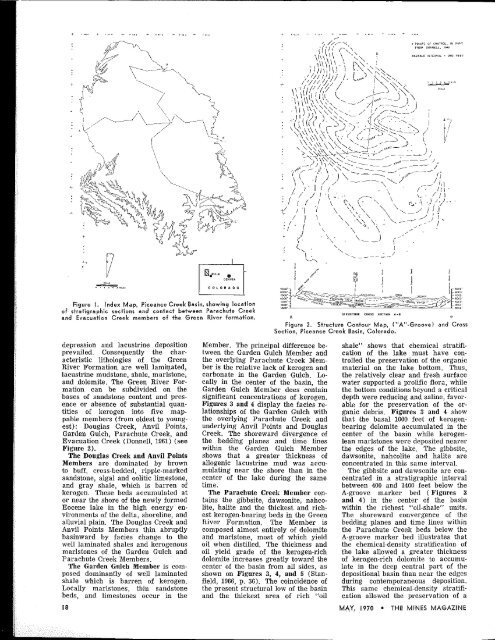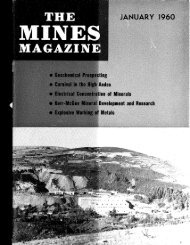Geological Engin. - Mines Magazine - Colorado School of Mines
Geological Engin. - Mines Magazine - Colorado School of Mines
Geological Engin. - Mines Magazine - Colorado School of Mines
- No tags were found...
You also want an ePaper? Increase the reach of your titles
YUMPU automatically turns print PDFs into web optimized ePapers that Google loves.
Figure I. Index Map, Piceance Creek Basin, showing location<strong>of</strong> s+rafigraphic sections and contact between Parachute Creekand Evacuation Creek members <strong>of</strong> the Green River formation.SECTION (I - BFigure 2. Structure Contour Map, ("A"-Groove) and CrossSection, Piceance Creek Basin, <strong>Colorado</strong>.depression and lacustrine depositionprevailed. Consequently the characteristiclithologies <strong>of</strong> the GreenRiver Formation are well laminated,lacustrine mudstone, shale, marlstone,and dolomite. The Green River Formationcan be subdivided on thebases <strong>of</strong> sandstone content and presenceor absence <strong>of</strong> substantial quantities<strong>of</strong> kerogen into five mappablemembers (from oldest to youngest): Douglas Creek, Anvil Points,Garden Gulch, Parachute Creek, andEvacuation Creek (Donnell, 1961) (seeFigure 2).The Douglas Creek and Anvil PointsMembers are dominated by brownto buff, cross-bedded, ripple-markedsandstone, algal and ooUtic limestone,and gray shale, which is barren <strong>of</strong>kerogen. These beds accumulated ator near the shore <strong>of</strong> the newly formedEocene lake in the high energy environments<strong>of</strong> the delta, shoreline, andalluvial plain. The Douglas Creek andAnvil Points Members thin abruptlybasinward by facies change to thewell laminated shales and kerogenousmarlstones <strong>of</strong> the Garden Gulch andParachute Creek Members.The Garden Gulch Member is composeddominantly <strong>of</strong> well laminatedshale which is barren <strong>of</strong> kerogen.Locally marlstones, thin sandstonebeds, and limestones occur in theMember. The principal difference betweenthe Garden Gulch Member andthe overlying Parachute Creek Memberis the relative lack <strong>of</strong> kerogen andcarbonate in the Garden Gulch. Locallyin the center <strong>of</strong> the basin, theGarden Gulch Member does containsignificant concentrations <strong>of</strong> kerogen.Figures 3 and 4 display the facies relationships<strong>of</strong> the Garden Gulch withthe overlying Parachute Creek andunderlying Anvil Points and DouglasCreek. The shoreward divergence <strong>of</strong>the bedding planes and time lineswithin the Garden Gulch Membershows that a greater thickness <strong>of</strong>allogenic lacustrine mud was accumulatingnear the shore than in thecenter <strong>of</strong> the lake during the sametime.The Parachute Creek Member containsthe gibbsite, dawsonite, nahcoiite,halite and the thickest and richestkerogen-bearing beds in the GreenFUver Formation, The Member iscomposed almost entirely <strong>of</strong> dolomiteand marlstone, most <strong>of</strong> which yieldoil when distilled. The thickness andoil yield grade <strong>of</strong> the kerogen-richdolomite increases greatly toward thecenter <strong>of</strong> the basin from all sides, asshown on Figures 3, 4, and 5 (Stanfield,1966, p. 36). The coincidence <strong>of</strong>the present structural low <strong>of</strong> the basinand the thickest area <strong>of</strong> rich "oilshale" shows that chemical stratification<strong>of</strong> the lake must have controlledthe preservation <strong>of</strong> the organicmaterial on the lake bottom. Thus,the relatively clear and fresh surfacewater supported a prolific flora, whilethe bottom conditions beyond a criticaldepth were reducing and saline, favorablefor the preservation <strong>of</strong> the organicdebris. Figures 3 and 4 showthat the basal 1000 feet <strong>of</strong> kerogenbearingdolomite accumulated in thecenter <strong>of</strong> the basin while kerogenleanmarlstones were deposited nearerthe edges <strong>of</strong> the lake. The gibbsite,dawsonite, nahcolite and halite areconcentrated in this same interval.The gibbsite and dawsonite are concentratedin a stratigraphic intervalbetween 400 and 1400 feet below theA-groove marker bed (Figures 3and 4) in the center <strong>of</strong> the basinwithin the richest "oil-shale" units.The shoreward convergence <strong>of</strong> thebedding planes and time lines withinthe Parachute Creek beds below theA-groove marker bed illustrates thatthe chemical-density stratification <strong>of</strong>the lake allowed a greater thickness<strong>of</strong> kerogen-rich dolomite to accumulatein the deep central part <strong>of</strong> thedepositional basin than near the edgesduring contemporaneous deposition.This same chemical-density stratificationallowed the preservation <strong>of</strong> agreater concentration <strong>of</strong> organic debrisand was probably a factor contributingto the formation <strong>of</strong> the gibbsite,dawsonite, and nahcolite. The conditionswhich allowed the preservation<strong>of</strong> the organic debris became morewidespread with the passage <strong>of</strong> time,permitting the accumulation <strong>of</strong> thebasinwide kerogen-rich Mahogonyzone ("a Mahogony Ledge") near thetop <strong>of</strong> the Parachute Creek Member.The A-groove marker bed is a widespread,thin, relatively kerogen-lean,tuffaceous dolomite bed which can beused effectively as an electric-logmarker for correlation purposes.Hence, the stratigraphic sections (Figures3 and 4) are hung on this marker.The upper 800 feet <strong>of</strong> the ParachuteCreek Member contains dawsonite,gibbsite, and nahcolite in significantquantities, although it is much moreirregularly distributed than in thelower portion.The Evacuation Creek Member iscomposed <strong>of</strong> buff to brown, lenticularsandstones, siltstones, kerogen-leanmarlstones, and shales, which accumulatedin the waning stages <strong>of</strong> thelacustrine deposition. Thus, the Memberincluded interbedded facies resultingfrom varying depositional environments: lacustrine (laminatedmarlstones and shales), shoreline,deltaic, and alluvial (standstones, siltstones,and nonlaminated shales). Thegradual restriction <strong>of</strong> the lake causedthe contact between the ParachuteCreek and the overlying EvacuationCreek Members to be gradational anda facies relationship. Hence, kerogenbearingmarlstone deposition persistedin the much-restricted lake in thebasin center long after non-lacustrineconditions overtook the rest <strong>of</strong> thebasin.Dawsonite and Gibbsite.—The distributioti<strong>of</strong> significant concentration18 MAY, 1970 • THE MINES MAGAZINETHE MINES MAGAZINE • MAY, 1970 19
















